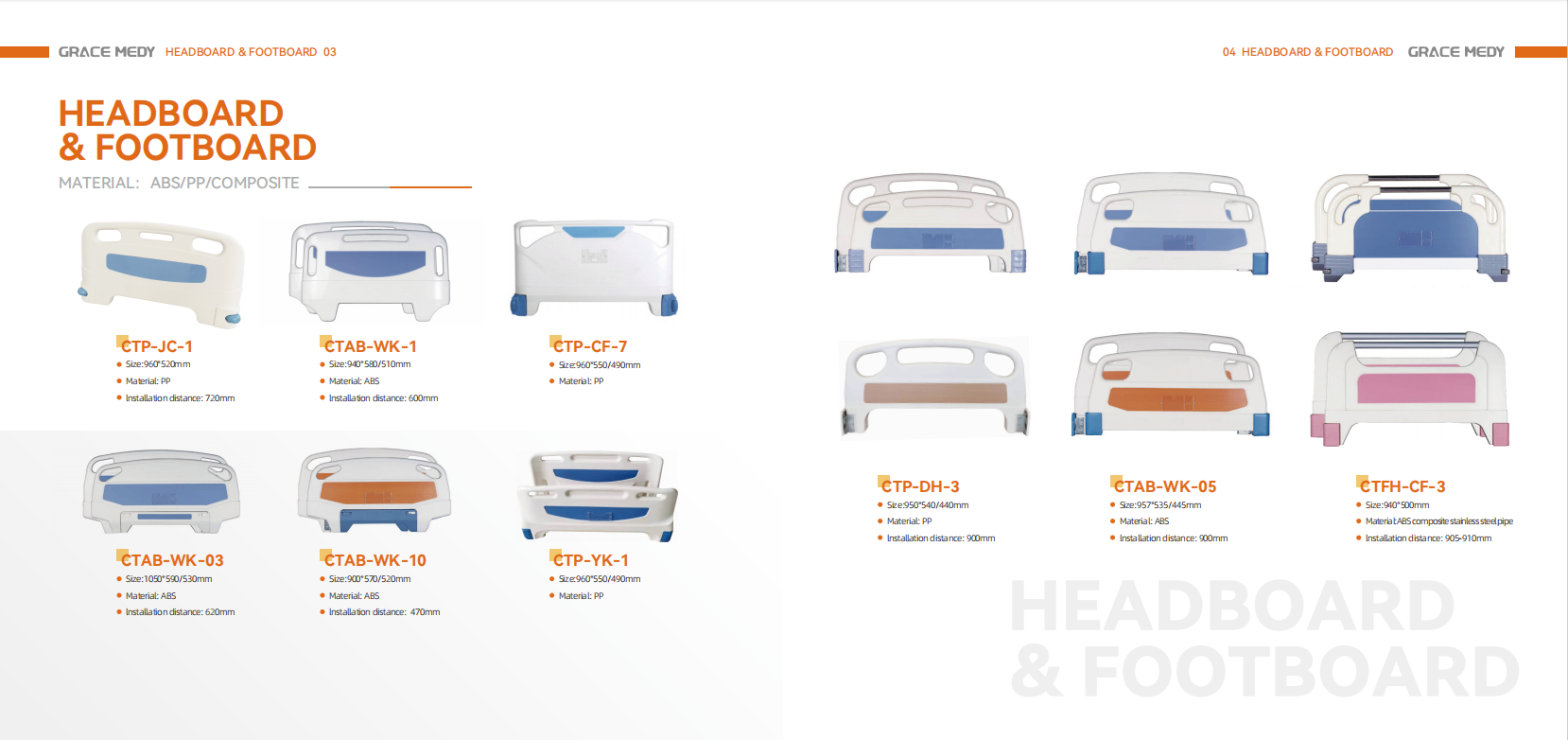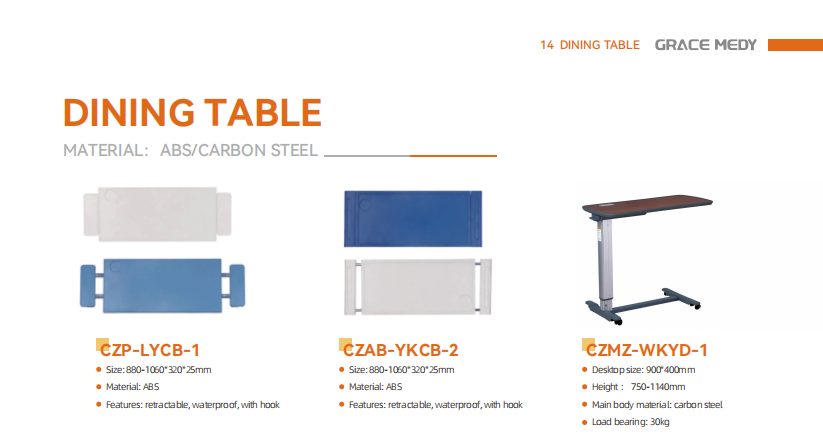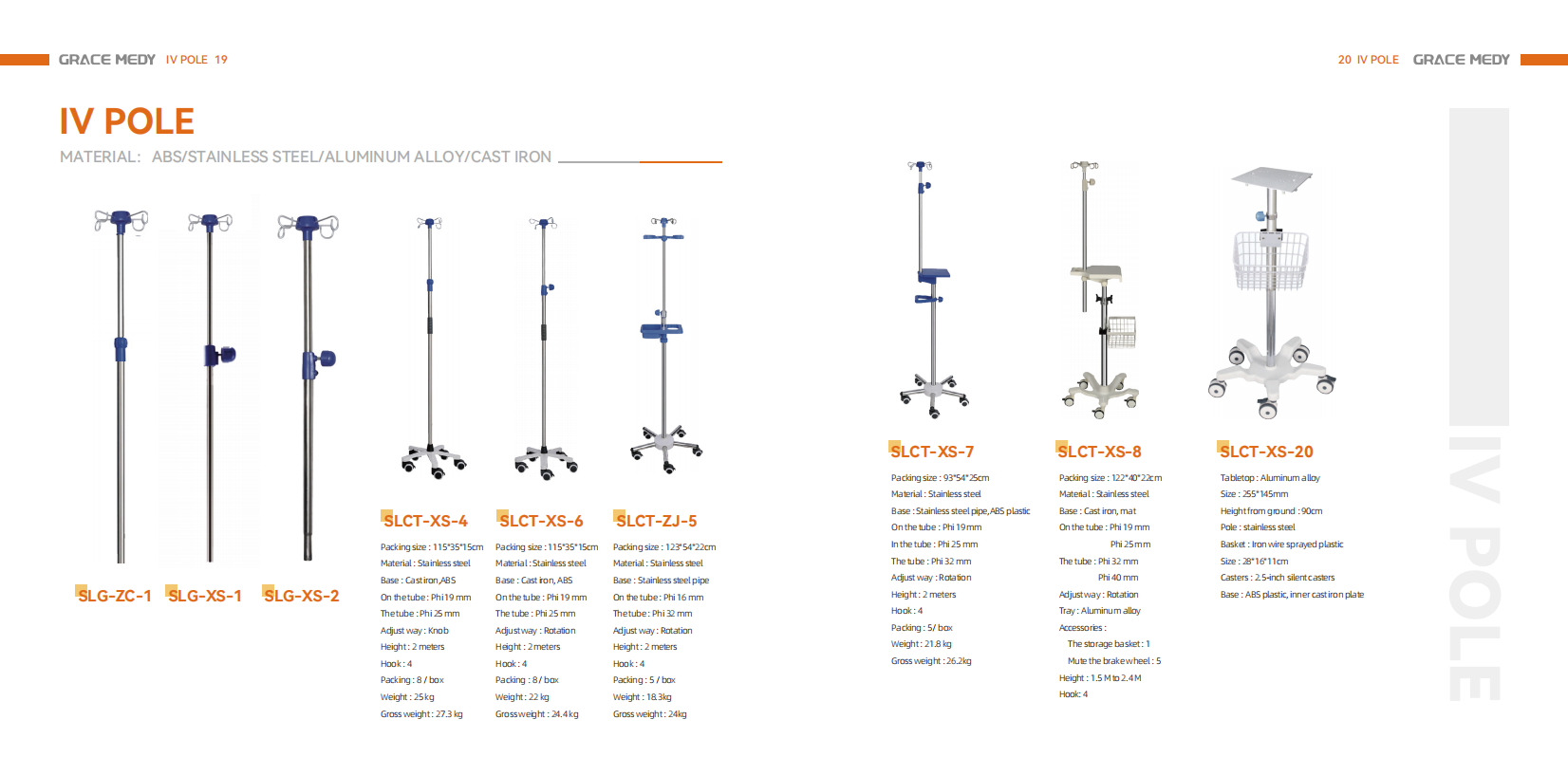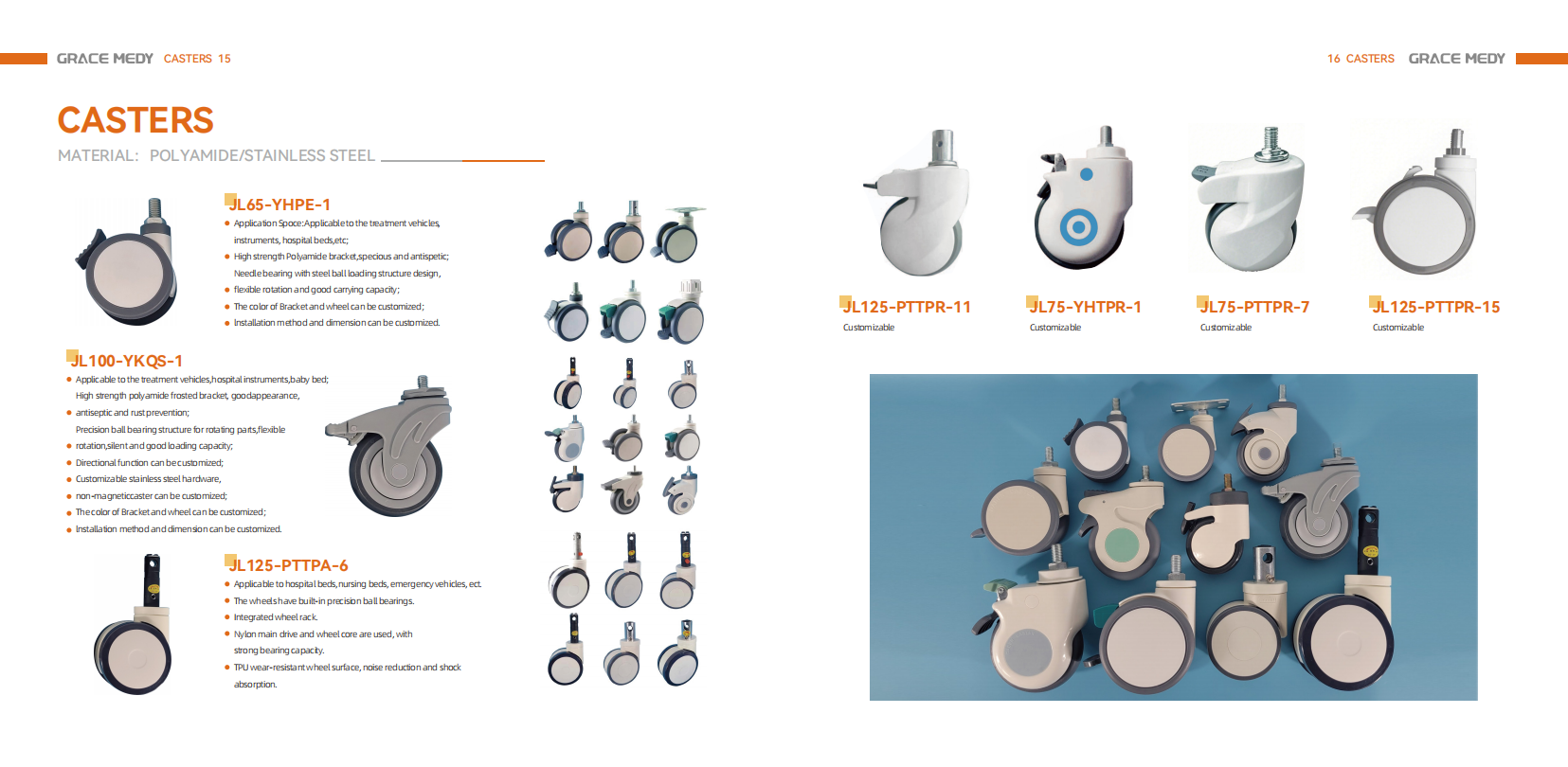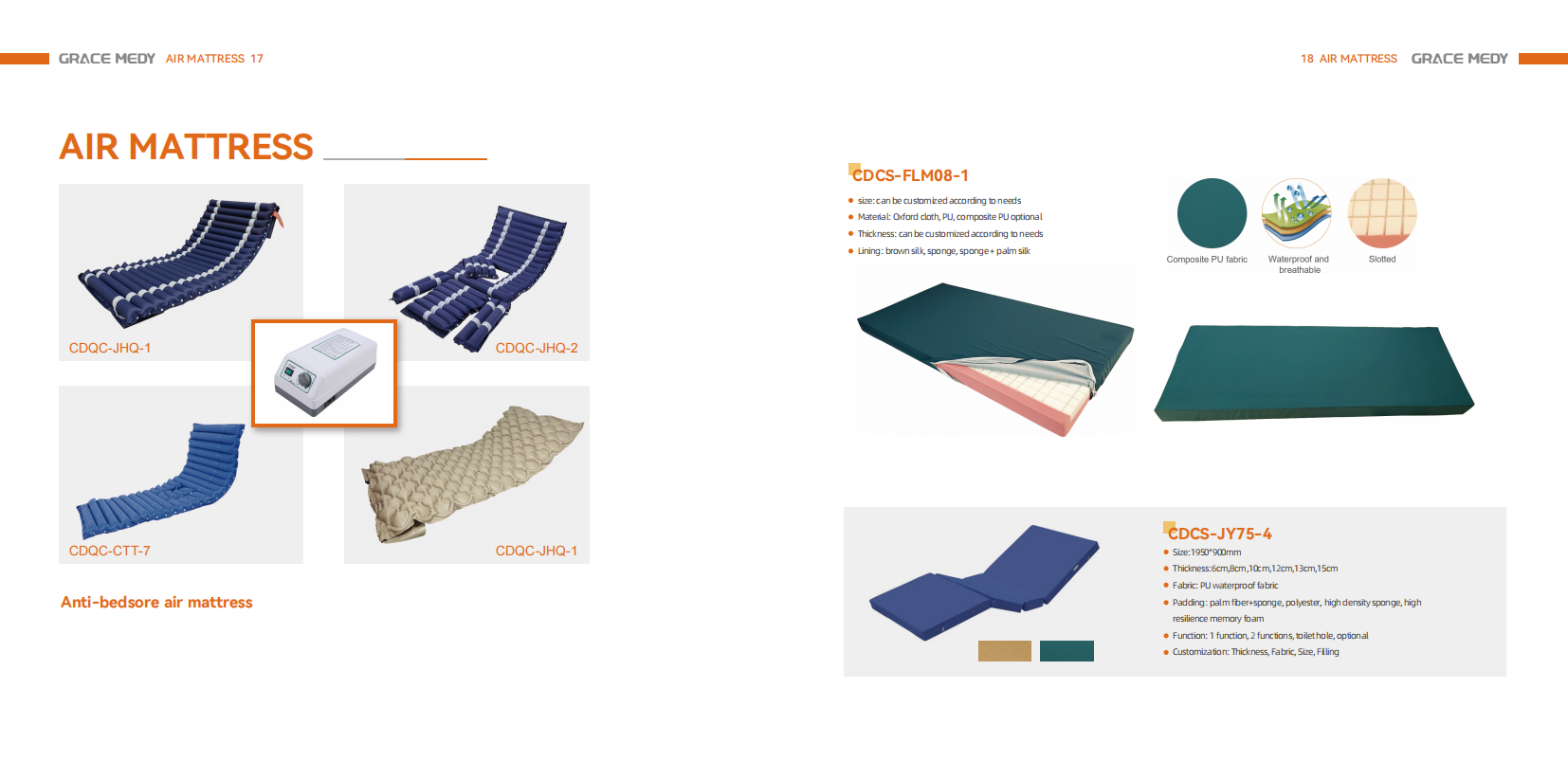Hospital Bed Accessories List
Commonly used hospital bed accessories are as follows:
Hospital Bed Headboard
Hospital Bed Rails
Overbed Tables
Trapeze Bars
IV Poles
Hospital Bed Casters
Hospital Bed Mattresses
What role do they play in hospital beds?Let’s explore next.
Hospital Bed Headboard
Hospital bed headboards are key hospital bed accessories at both ends that provide support and serve many purposes. They are made from ABS plastic with these benefits:
Durability: These headboards resist impacts and pressure, reducing damage.
Easy to clean: The smooth surfaces make cleaning and disinfecting simple, keeping medical spaces clean.
Light yet strong: I find they’re easy to move while still being sturdy.
Resists chemicals: They won’t break down when exposed to cleaning products and medicines.
Below pictures is Grace Medy hospital bed headboard & footboard:
Key Features of Modern Hospital Bed Headboards
Bump-proof design: Lowers the chance of damage to nearby walls and medical tools.
Comfort-shaped: Gives patients the support and comfort they need during their hospital stay.
Added Features
Color Choices: These come in neutral colors that blend well with hospital settings.
Easy to remove: I like that they can be taken off for cleaning or replacement, which helps keep the space clean and running well.
Hospital bed headboards make patients more comfortable and help staff work better in medical rooms.
Hospital Bed Rails
I find bed rails is essential hospital bed accessories for patient safety and support. These below Grace Medy hospital bed rails attach to the sides of hospital beds and help stop falls, aid in changing positions, and make it easier to get in and out of bed.
Types of Hospital Bed Rails
- Full-Length Rails
These cover the whole bed length. They give the most protection and support. - Half-Length Rails
These cover about half the bed length. They balance safety with easy access. - Quarter Rails
These shorter rails give support in key areas, mainly near the head of the bed. - Assist Rails
These rails help patients sit up or move between surfaces.
Key Features and Considerations
Made from durable materials like steel or strong plastic.
Come with height settings and locks for better safety.
Some models fold down or swing away for easier access.
Overbed Tables
I find overbed tables to be must-have hospital bed add-ons that give a firm, flat surface for many tasks. Patients can eat, work, or keep their things on these tables while in bed. For nurses and doctors, these tables make a handy spot to set medical items during care.
Key Features and Uses of Overbed Tables
Height Adjustability: These tables can change height for all beds, ranging from 28″ to 45″ high.
Weight Support: They can hold between 50-100 lbs when items are spread out across the top.
Functional Tops:
Flat or tiltable tops for reading or using devices.
Some have spill guards, cup holders, and storage drawers.
Versatile Usage:
Great for meals, personal items, fun tasks, and holding medical gear.
They help patients be more self-reliant and feel better while resting.
They make care tasks easier for nurses and helpers.
Materials
Tabletops:
Made of laminate, thermoform plastic, or ABS plastic for tough, easy-to-clean surfaces.
Frames:
Built with steel, aluminum, or strong plastic for lasting durability.
Sanitation:
All parts are made for germ control and easy cleaning.
Additional Features
Mobility and Stability:
Come with wheels that lock for safe placement.
Handles are shaped to make moving the table simple.
I’ve seen how these tables make life better for patients. They boost comfort, help with daily tasks, and play a key role in making the care setting more pleasant.
Trapeze Bars
Trapeze bars are must-have hospital bed tools that help patients move on their own. Most nursing hospital bed will with this hospital bed accessories.They help with many tasks, from changing position to helping with therapy. I find their many uses helpful for both patients and caregivers.
Benefits of Trapeze Bars
- Aid in Mobility: These bars help patients with weak legs move in bed or transfer to a wheelchair.
- More Freedom: Patients can move without help, which boosts their confidence and keeps their dignity.
- Reduce Injuries: They make transfers safer and cut down on falls and other accidents.
- Hold Weight: Basic bars hold up to 250 lbs. Larger models support between 450-600 lbs.
- Help with Recovery: I’ve seen them used as workout tools to build upper body strength during therapy.
- Adjustable Height: Most bars can be set between 43″ and 52″ for comfort.
- Easy to Set Up: You can choose free-standing bars with floor stands or models that attach to bed frames.
More Helpful Info
Grace Medy shows how trapeze bars help prevent bedsores. Patients can turn themselves, which helps avoid pressure on one spot for too long. They also make caregivers’ jobs easier by cutting down on the effort needed to move patients.
IV Poles
IV poles are must-have hospital bed accessories items in hospitals for holding fluid bags and medicines for patient care. They have stands you can adjust in height with hooks at the top to hang IV bags. Many come with wheels on the base so patients can move around during treatment.
Key Features of IV Poles
Adjustable Heights: Range from 45 to 90 inches, with push buttons, grip handles, or clamps to set the height.
Multiple Hooks: Have 2 to 6 hooks to hold several IV bags or pumps at once.
Stable Bases: Most have 5-6 legs with wheels for good balance and easy movement.
Materials: Made from strong metals like stainless steel, coated steel, or aluminum that last a long time.
Weight Capacities: Can hold up to 45 pounds for different medical needs.
Types of IV Poles
Economy IV Poles: Low-cost options for basic needs.
Heavy-Duty IV Poles: Strong poles that can hold many pumps and heavy items.
MRI-Compatible Poles: Made without metal for use in MRI rooms.
Ceiling or Wall-Mounted Poles: Save floor space in small rooms.
Disposable Poles: One-time-use poles often used in homes.
Selection Tips
I suggest looking at how strong, stable, and movable an IV pole is when choosing one. I find that stainless steel poles last longer than chrome-plated ones for long-term use. Make sure the pole works with your other medical gear. This helps it fit well in both hospitals and home care.
Hospital Bed Casters
Hospital bed wheels are key hospital bed accessories parts that help beds move, stay stable, and support good patient care. These wheels make it easy to move beds smoothly and place them exactly where needed.
Types of Hospital Bed Casters
- Swivel Casters:
These wheels turn in all directions. I find they help move beds easily in small spaces. - Locking Casters:
These wheels have locks to stop movement. This keeps patients safe. - Directional Casters:
These wheels move in straight lines. This gives better control when moving beds.
Common Features of Hospital Bed Casters
Non-Marking Wheels: Keep floors clean without marks.
Quiet Wheels: Made to reduce noise for a peaceful setting.
Chemical Resistance: Strong materials that can be cleaned with harsh cleaners.
Shock-Absorbing Design: Makes bed moves more comfortable for patients.
Braking Mechanisms
Total Lock: Stops both turning and rolling for full control.
Directional Lock: Limits movement to forward and backward for better control.
Central Locking System: Locks or unlocks all wheels at once for easy use.
Benefits of Using Hospital Bed Casters
Makes moving heavy beds easier, even in tight spaces.
Helps move patients smoothly between hospital areas.
Cuts down on staff strain, making work easier.
Lets beds be placed just right for medical care.
Keeps patients safe and comfy during moves or when still.
Hospital Bed Mattresses
Hospital bed mattresses play a key role in patient comfort, support, and safety. These mattresses come in many types to meet different patient needs. Here are the main types I’ve worked with:
Types of Hospital Bed Mattresses
Foam Mattresses: The most common option. They have layers of foam – soft on top for comfort and firm at the bottom for support. Some include memory foam that shapes to the body, helping patients who need both support and pressure relief.
Alternating Pressure Mattresses: These have air cells that inflate and deflate to shift pressure points. I recommend these for preventing and treating pressure ulcers.
Low Air Loss Mattresses: These contain small holes that let air flow through. This controls skin moisture and temperature. They work well for patients with high risk of pressure sores.
Gel Mattresses: These spread weight across the surface, cut down on pressure points, and keep patients cool. I find them great for comfort and managing body heat.
Bariatric Mattresses: Made for patients over 350 lbs. They use stronger materials like dense foam and sturdy internal frames for better support and longer life.
Summary
I’ve seen how important hospital bed accessories are for patient care. Each part plays a key role. Headboards give support while trapeze bars help patients move. Together, these items create a space where healing can happen.
As medical care changes, these tools will also change. Their main goal stays the same – to boost comfort, safety, and healing.
These simple extras have smart designs. I’m struck by how small things in healthcare can greatly impact a patient’s recovery. In my experience, even tiny details matter when someone is working to recovery.

